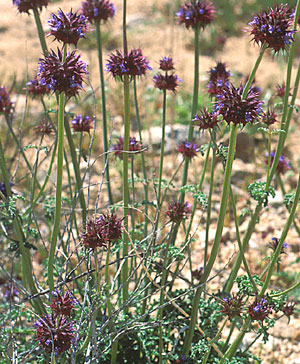Salvia columbariae
Salvia columbariae, commonly known as chia, golden chia, or desert chia, is a flowering plant in the mint family, Lamiaceae, native to the southwestern United States and Mexico. It is an annual herb, notable for its rich blue to purple flowers and its seeds, which have been a food source for indigenous peoples of the region for millennia.
Description
Salvia columbariae grows to a height of 10 to 50 cm, with lance-shaped to triangular leaves that are 1 to 5 cm long and 0.5 to 2 cm wide. The plant produces small, tubular flowers in shades of blue to purple, arranged in dense clusters. The seeds of Salvia columbariae are small, oval, and mottled, known for their high omega-3 fatty acid content, making them a nutritious addition to the diet.
Distribution and Habitat
Salvia columbariae is found in the deserts and arid lands of the southwestern United States, including California, Arizona, Nevada, and Utah, as well as in Mexico. It thrives in sandy or rocky soils, often in open or disturbed areas, from sea level to elevations of about 2,400 meters.
Uses
Historically, Salvia columbariae has been an important food source for Native American tribes such as the Chumash, Cahuilla, and Kumeyaay. The seeds, known as chia, were ground into flour, mixed with water to form a gel, or pressed into cakes. Today, chia seeds are recognized for their nutritional benefits, including high fiber, protein, and omega-3 content, and are used in a variety of health foods.
Cultivation
While Salvia columbariae is primarily wild-harvested, it can be cultivated in gardens as an ornamental plant or for its seeds. It prefers full sun and well-drained soils, requiring minimal water once established. The plant is drought-tolerant, making it suitable for xeriscaping or arid garden designs.
Conservation
Although Salvia columbariae is not currently listed as endangered, its habitat is threatened by urbanization, agriculture, and overgrazing. Conservation efforts focus on habitat preservation and sustainable harvesting practices to ensure the species' survival.
See Also
Salvia columbariae
Transform your life with W8MD's budget GLP-1 injections from $125.
W8MD offers a medical weight loss program to lose weight in Philadelphia. Our physician-supervised medical weight loss provides:
- Most insurances accepted or discounted self-pay rates. We will obtain insurance prior authorizations if needed.
- Generic GLP1 weight loss injections from $125 for the starting dose.
- Also offer prescription weight loss medications including Phentermine, Qsymia, Diethylpropion, Contrave etc.
NYC weight loss doctor appointments
Start your NYC weight loss journey today at our NYC medical weight loss and Philadelphia medical weight loss clinics.
- Call 718-946-5500 to lose weight in NYC or for medical weight loss in Philadelphia 215-676-2334.
- Tags:NYC medical weight loss, Philadelphia lose weight Zepbound NYC, Budget GLP1 weight loss injections, Wegovy Philadelphia, Wegovy NYC, Philadelphia medical weight loss, Brookly weight loss and Wegovy NYC
|
WikiMD's Wellness Encyclopedia |
| Let Food Be Thy Medicine Medicine Thy Food - Hippocrates |
Medical Disclaimer: WikiMD is not a substitute for professional medical advice. The information on WikiMD is provided as an information resource only, may be incorrect, outdated or misleading, and is not to be used or relied on for any diagnostic or treatment purposes. Please consult your health care provider before making any healthcare decisions or for guidance about a specific medical condition. WikiMD expressly disclaims responsibility, and shall have no liability, for any damages, loss, injury, or liability whatsoever suffered as a result of your reliance on the information contained in this site. By visiting this site you agree to the foregoing terms and conditions, which may from time to time be changed or supplemented by WikiMD. If you do not agree to the foregoing terms and conditions, you should not enter or use this site. See full disclaimer.
Credits:Most images are courtesy of Wikimedia commons, and templates, categories Wikipedia, licensed under CC BY SA or similar.
Contributors: Prab R. Tumpati, MD


